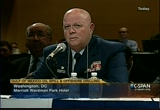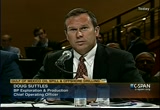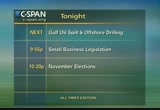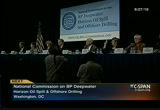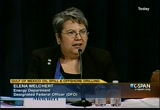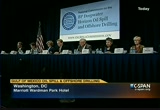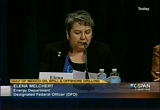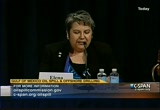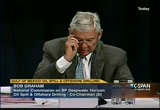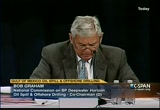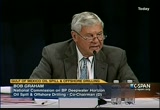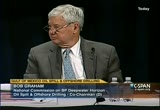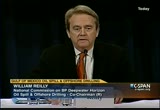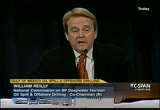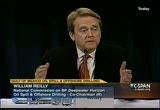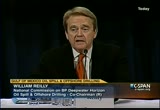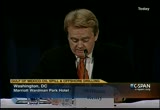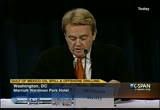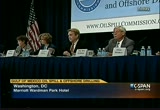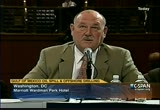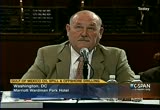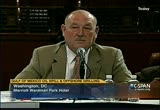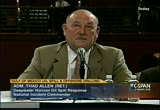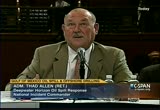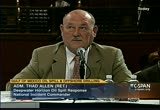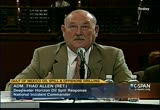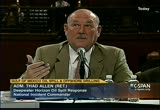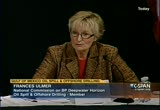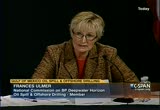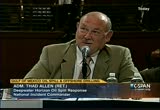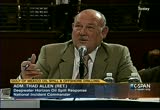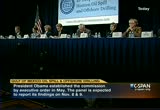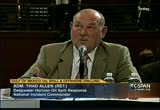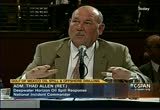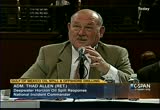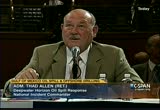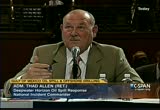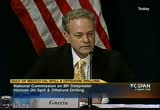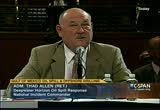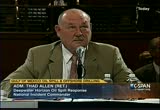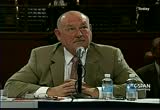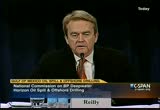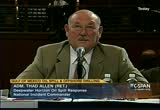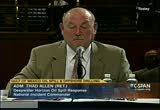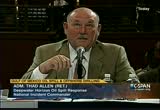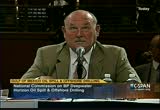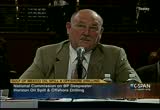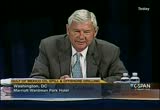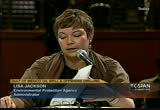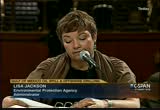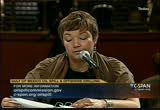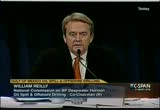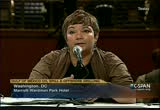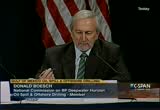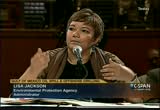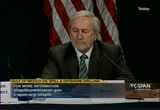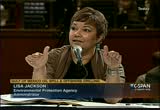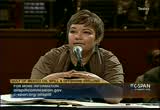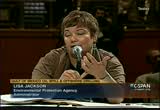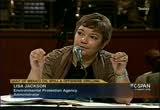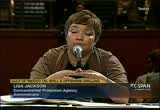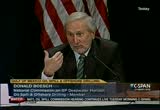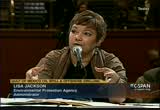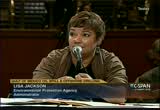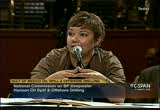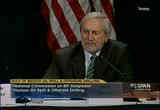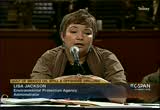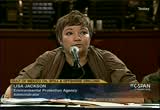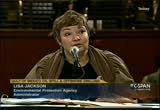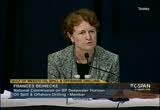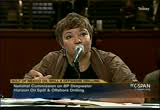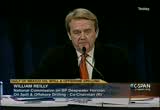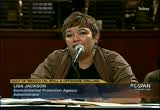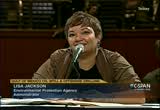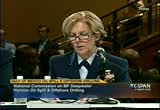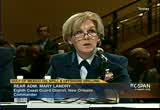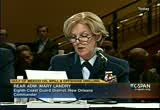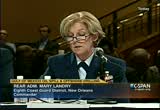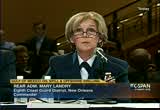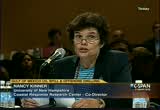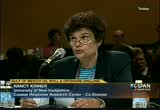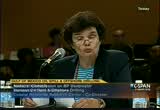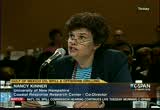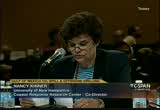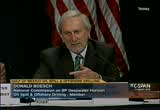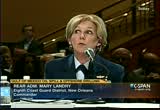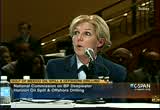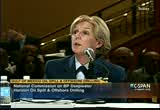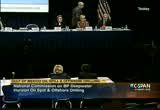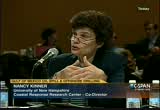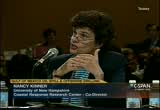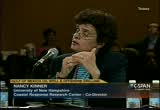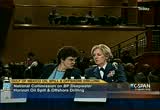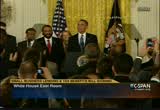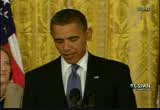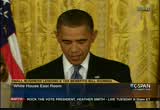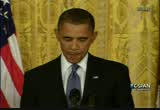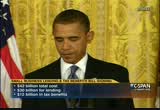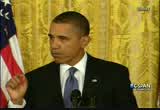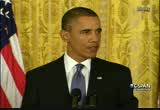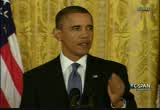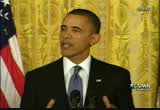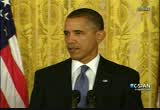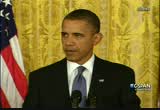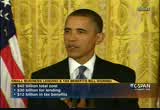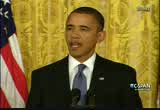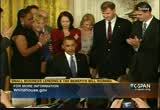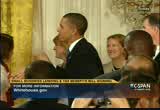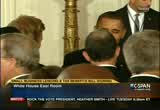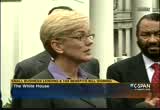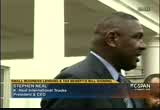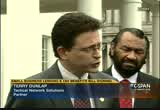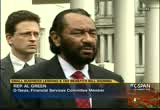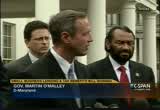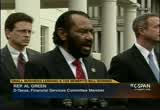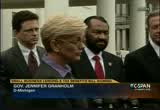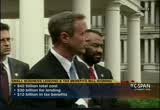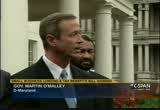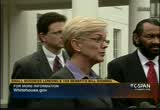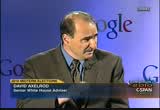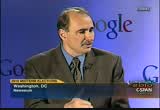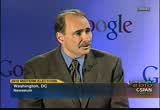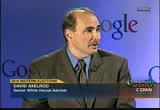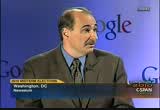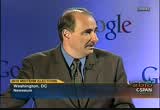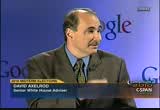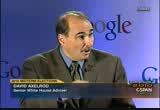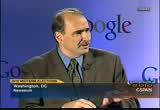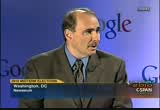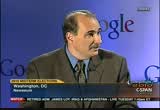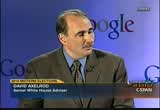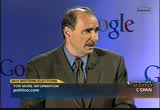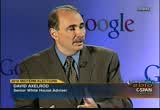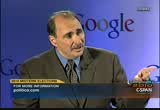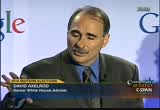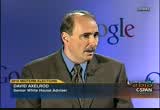tv Tonight From Washington CSPAN September 27, 2010 8:00pm-11:00pm EDT
8:00 pm
mr. suttles. once the moratorium is lifted, one assumes that there will be a resumption of drilling. and yet that is contingent on satisfaction of notice to lessees 5 and 6. do your wells currently conform to the requirements in those two ntls? >> i'm not deeply familiar with the details of 5 and 6. as i sit here. but i do know that we're going through the ntls as they come out. and are looking at our capability to meet those and, of course, we'll have to meet those to go back to work. and any additional ntls the boem issue as a precondition to restarting. i think from those two already, what is clear is that certain equipment, certain wells, certain rigs are going to be --
8:01 pm
find it easier to meet those requirements quickly than others. and i would expect the net effect of that to be, if you will, a phased restart. >> thank you. >> thank you very much. i appreciate your extremely informative based on close hands-on with this tragedy. and we would like to make a request that we might recontact you with some written questions as they might emerge in the future. >> that would be my pleasure. >> thank you, senator. >> thank you very much. >> gentlemen, we will take a brief recess until 11:25. >> a forum on the gulf of mexico oil spill, and the future of
8:02 pm
offshore drilling. we will hear from admiral thad allen. president obama signs a small bags -- business package into law. david axelrod and republican strategist ann gillespie talk about the midterm elections. >> i trust that following my testimony, both sides will work together on this issue in the best interest of the american people, as you always do. >> whether poking fun at congress or dealing with issues more seriously, celebrities have often appeared in washington. take a look at their causes with these c-span video library. nearly every program since 1987. search for a name you might know, any time. the person who oversaw the federal response to the bp oil spill said earlier that government officials should have been better prepared for the
8:03 pm
disaster. thad allen testifies before the national commission on the bp deepwater horizon oil spill. this portion is 50 minutes. >> good morning. i am elena melkert from the part -- department of energy. i have been appointed by the designated federal officer, christopher smith, to serve as the designated federal officer. i will continue as the designated federal officer. i now come to order this meeting of the commission on the bp oil
8:04 pm
spill and offshore drilling. the president established this bipartisan commission to examine the root causes of the bp deepwater horizon oil disaster, to provide recommendations on how our future accident could be prevented, and recommendations on how to mitigate the impact it an accident should happen again. the president appointed to cochairs -- two co-chairs to lead this commission. the commission has been rounded out by five other distinguished americans who were selected based on their extensive scientific, legal, engineering, and environmental expertise and their knowledge of issues pertaining to offshore operations. they are frances feinike, dawn
8:05 pm
bosch, terry garcia, executive vice president, national geographic society, dr. cherry [unintelligible] and fran ulmer, from the university of alaska at anchorage. the act sets a high standard for openness and transparency. today's hearing is being held in this public forum and is being broadcast live via video feed. before hand control of the meeting over, i will review today's agenda. our first panel will begin focusing on decision making within the unified command. we will have five panelists.
8:06 pm
after a short break, at 11:15 a.m., a panel member to will focus on the amount and state of the oil with five panelists. we will take a short break for lunch and at 1:30 p.m., we reconvened with panel 3 on the use of dispersants with three panelists. add to 30 5:00 p.m., panel four will focus on the future of onshore drilling, and we will have three panelists there. at 335 pm, panel 5 lil 0 -- focus on the response in the arctic. we will have five panelists. after a short break, we convene at 5:00 p.m. to begin the public comment period, and at 5:30 p.m., we will adjourn. any member of the public would like to submit a comment made do so via the web site at oilspillcommission.gov. we have a full agenda and we
8:07 pm
respect everyone's time. we asked all the panelists to please stay within the time limits in order to allow ample time for the commissioners to ask questions. there is a timekeeper right here in front who will monitor the time. we ask the panelists to please begin to summarize their remarks when they reach the timekeeper's one minute mark. i give control of the meeting to our cochairs, senator bob graham and the honorable william reilly. >> thank you. winston churchill described in event as not being the end or the beginning of the end, but perhaps the end of the beginning. today, i would describe the
8:08 pm
commission as an ending the first phase of our work. we have been in an information gathering mode, hearing from people of the gulf, government officials, scholars, and experts from industry, nonprofits, and academia. next, we will turn to presenting our findings and beginning our deliberations. in early november, our chief counsel will give a detailed presentation about what happened on the deepwater horizon rig and provide this but we trust will be the most comprehensive, clear, and impartial accounting that the american people have received. but for today, and tomorrow, the end of the beginning, we will be learning about a very crucial issues that we will in form -- that will inform future offshore drilling efforts.
8:09 pm
the response to spills and the restoration of damaged ecosystems. we have learned in the course of the investigation about the enormous transformation and how we exploit our domestic energy resources. the growth of drilling in the deep water off the coast has been rapid and with profound implications for energy supply and the integrity of the fragile environments in which that exploitation occurs. in our meetings last month, it was clear that our regulatory approach did not adapt to the new reality. i remain concerned that scientists -- science does not have an appropriate place at the table. we live in a world of rapidly changing technology. not just in terms of energy, but in many other areas. in finance, cyber security, in food production, and weapons of mass destruction, and many others. if we're not vigilant, our laws
8:10 pm
and response capabilities will not keep pace with changes in technology. we ignore science and what it can tell us about how we manage risk and respond to it at our peril. five years ago, just five years after the gulf suffer the devastation of hurricane katrina, many have the same question about whether the government moved quickly enough and was effective enough in its activity, it's communication, and its partnership with state and local governments. we need to look at this response in the broader context of how our federal, state, and local government mobilized against disasters. much was done well in responding to this bill. -- spill. other things, not so. i look forward to hearing our panelists, getting their thoughts about what we have learned and where we go from here. the end of the beginning to the end. thank you.
8:11 pm
>> thank you. good morning. since our inception, this commission has been intensely engaged in examining the causes, including direct cause of the catastrophe of the macabre welland blow up. we have interviewed officials at the highest levels. we have had an extensive -- we have had extensive interviews and briefings from industry. we have completed one phase of information gathering and we will continue to gather information in the weeks ahead. we have as many of you know, a very abbreviated schedule. it is probably the shortest of any commission that has had the mission of investigating a disaster. in this case, if we had suffered the peculiar consequence of investigating a disaster that was ongoing, even as we
8:12 pm
researched it. we spent a good deal of time at the last hearings examining the role of industry and particularly reflecting on the way in which the experience and research that we had developed suggested a profound need for reform of the culture of industry, and for better 10 -- attention to process safety, particularly as industry explores in what is the most promising area of development, the very deep water. that poses more risks and more challenges than previous drilling in shallow water ever did. we have considered industry culture and the tenses -- attention to press the safety. we turn to the government itself, to its priorities and processes of the quality of its
8:13 pm
primary regulatory entity for overseeing safety and for it -- enforcement of environmental laws in the offshore to permit, which is the department of the interior. the effectiveness of the response to the spill at its more than the interior department. that involves many agencies of the government, several of which will be presented this morning and many of whose officials we have talked to already. i have to say that as someone intimately familiar with the experience in prince william sound after exxon valdez, i continued to be amazed and disappointed at the failure of the technology response to revolve war that has. particularly in view of the tremendous advances made in the technology of drilling itself. the skimmers, we are informed by noaa, i saw a flotilla of
8:14 pm
them when i flew out to the raid, succeeded in gathering up 33%. dispersants got that up to about 13. given the amount -- the enormous effort, it seems to me a very disappointing results, frankly. the consequence of a lot of things, one of which is the failure of technology. the skimmers, the booms, the dispersants to be involved and developed. we will raise some of those questions today. we will consider the use of dispersants, and we will discuss how and why they were employed in the gulf. in such quantities [unintelligible] both of which represent novel uses of dispersants and suggest there was enormous confidence placed in dispersants, more
8:15 pm
confidence than i allowed in prince william sound where the dispersants were more troublesome and more toxic than they are today. we will learn more about that. looking at the quality of specific decisions, i think it is important and this is what is a fundamental question. how did we get here? how did we get into a situation where the need to improvise was so great? in many cases, the response demonstrated a tremendous dedication and ingenuity that is a credit to the many thousands, tens of thousands of people who participated in this cleanup. from where i said, it is difficult to make the case that we were well-prepared. oil exploration continues in frontier in vermins and --
8:16 pm
ments.meenviron how would we respond if a similar situation occurred under the sea ice in the arctic today or tomorrow? the blowout and its consequences created a situation where the party responsible for the spill had, by necessity, to play a central role in responding to it. we should be happy that they did, and had, and are. this uneasy partnership between the government and the responsible party raises important questions about decision making power about the flow of information, and proper oversight. in our political system, there is also a partnership, sometimes uneasy, between the federal government and the states and communities.
8:17 pm
we're all aware of the issues and the aftermath of this bill, concerned about the speed of the response -- of the spill, concerned about the speed of the response and the efforts. looking back, i think we need to learn from this spill, and that is part of what this commission is about. we learned from exxon valdez that tanker operations were safer than they were 20 years ago. the pollution act of 1990 has been criticized for having -- a response to the last war. it is my hope that the lessons we learned from the response this time did not just fix what went wrong in the past, but creative culture that eliminates complacency. in industry, and in government. thank you.
8:18 pm
>> thank you. we commence with panel one, decision making within unified command. we are pleased to have as our first witness today admiral thad allen, a national incident commander for the unified command. when he completes his introductory statement, our lead questioner will be frances ulmer. remarks are spot on. it is my pleasure to be here and have this discussion with you. i did not submit a statement for the record. there has been a lot of information provided to you. i would make this officer -- this offer. we started developing a strategy
8:19 pm
for the doctrinal changes that were being made as we improvised and adapted to this bill. -- this spill. i collected this information and updated it several weeks into an inversion. that will be the seminal record . i have version 4.0. it has become a rather voluminous document. 5.0 will be 500 pages. i ask that we be able to submit that for the commission to use for the record, and we will do that when the next version is published. i would like to talk about four things this morning in the opening statement. i would be glad to take questions. i would like to go for the rationale by which the national incident command was established. to talk about some of the challenges you have noted, some of the successes we did enjoy, and i think the implications for the future is we take a look at current oil spill doctrine and
8:20 pm
what we need to do to position for the next war, if you will. i would subscribe to your concept that the open idea of implementation was tanker- centric. it is an achievement in tanker safety. when we develop protocols on dispersant use at the area level, deep water drilling moved offshore. we stopped funding research and development, interagency process is to do that and move forward. it became the nine. by the time the middle 1990's ground, what was anticipated to be a robust research and development interagency process was shepherding meager amounts of money amount -- around the agencies. we need to look at r&d and what we're doing in relation to the technologies that will be employed in the future. when i was designated as the national incident commander, i sat down with a small group of
8:21 pm
folks who became my cadre and senior staff. i wanted to focus on what needed to be done about the universe -- above the unified level that had been established. i wanted to focus on those things that were distracting unified area command from doing their job. working enter agency issues in washington and dealing with the governmental structures, congress and so forth, and not duplicate or the some tactical control from washington. i was a 39-year veteran of the coast guard. the last thing we want is the 3,000 mile screwdriver. we would leave tactical control as close to the problem as we could. we would try to prevent -- develop awareness in washington and staff and myself would travel weekly. not only to -- see what was
8:22 pm
going on but to take care of extraordinary amounts of data that led to the various levels of government and deal with the media. i would like to characterize the national incident command as a thin client. to use a software term. necessary to integrate but no more than what is necessary and without adding layers of bureaucracy. the incident command system that was established in new orleans was the basis for the of coronation of command. -- to the coronation of command. that is a sound system. incident command is one of the ways to approach these spills. if we look at what transpired, we need to know what the basic doctrine says against the reality of what we found on the ground, which was not a large, monolithic oil spill that we
8:23 pm
experienced with exxon valdez. oil that came to the surface under different conditions each day, different wind and current. we did not have a large, monolithic oil spill. we had hundreds of thousands of patches of oil that moved in different directions over time that moved beyond the geographical area that was contemplated in any response plan, putting the entire coast at risk. that required resources above the plan. it required coordination across state boundaries and federal regional boundaries for the team. those other types of issues i think that were generated in this spill that set it apart from the spill's we have dealt with since the world pollution act of 1990 was an act. -- was passed. the act has served well. we have worked on smaller spills with state and local governments with smaller -- responsible parties. some of the anomalies associated
8:24 pm
with this spill that challenged the doctrine need to be looked at in detail for constructive changes to the contingency plan which should remain in place, and how we need to manage large, and, as evidence in the future that defy the traditional parameters of the incident command system. if i can go over a couple of those in terms of challenges, that would be useful. first, i think we need greater clarity moving forward on what the responsible parties, who they are, what they do, and how they interact with the contingency plan. we have worked with the responsible parties for over 20 years, very effectively managing oil spills. with the enormity of this spill, and the end -- they determine that -- indeterminate nature of it, without a plan
8:25 pm
[unintelligible] trying to explain that to the public and national leaders became a challenging. there were two basic issues that were not well understood by most of the people of the u.s. and political leaders. there would be a constructive role for the entity that was attributed to causing the event. that created concern that could not be explained away. even though we had worked effectively in that construct in responding to oil spills. the second is the fiduciary link between the representative of the responsible party and unified command and their shareholders. there are legal requirements for documenting costs which you have to carry on a balance sheet that they cannot sever. the second notion was difficult for the people of this country to understand and our political leaders was ultimately, there is a fiduciary link between the
8:26 pm
responsible party and shareholders which would bring into question whether or not a decision should have been made based on the environment and the response itself. as it stated in the national contingency plan and by statute, the responsible party is to resource the response and the federal government is to oversee their response. greeting -- in greeting the act of 1990, we greeted an industry of responders and the presumption was that responsible party would bring resources to respond to the spill under the supervision of the federal government. that is what occurred, but as you look at the enormity of this response, and the local implication, the isolated geographical areas where access is an issue, where logistical support for this type of response is an issue, a lot of the details that are carried out by those contractors that are
8:27 pm
brought to the scene are done in a contractual obligation basis with the responsible party under the general supervision of the federal government, and partially -- part way through this spill, we employed additional state and local personnel, provide a local supervision to make decision making closer to where the oil was that and the response to feedback, too much of that was being made locally by local contractors. there is a discussion about what constitutes a authority to take action, the day-to-day supervision of workers. how the gets interpreted in terms of feedback and the effects you are trying to achieve. there is a couple of things we need to do. we need to look at the contingency plan and think about what we need by the concept of responsible party and how we want that to look in the future. something we might want to consider is the creation of a qualified individual that would represent the industry, who has
8:28 pm
access to resources and will be a firewall by any fiduciary link to the shareholders, almost putting the resources in trust and executed by an industry expert. the issue of r&d has to be addressed. we cannot be doing r&d in the middle of a spill response. those things have to be proven when we need them. i believe a certain number of delegations could be made in the law that would allow us to have greater access to the spill trust fund, to replenish it when we need to, and to kick in when the spill was declared. i would be glad to take any questions you have for me. >> thank you, admiral. ms. ulmer. >> i would like to thank you for serving as the national incident commander and the many hours you've put into doing your very best. through you, i would like to thank the men and women of the
8:29 pm
united states coast guard to do an amazing job in many different ways. in alaska from fisheries management to an emergency response, the coast guard is very important -- a very important way in which we stay safe and manage our resources. thank you for resources. >> thank you on behalf of the men and women of the coast guard. >> i am concerned about two things. i will ask you to address them. one is the resources of the united states coast guard. not only all of the things that have been for many years, the responsibility of the coast guard, but after 9/11, the additional national security issues, and in emergencies like the gulf of mexico oil spill, the need to staff up quickly and deploy or worse -- deploy resources, sometimes resources you do not have. i am concerned about the implications for alaska and if you have the kind of efforts
8:30 pm
that will be necessary moving forward. that is one concern. the second, you addressed the relationship between the national incident command and the responsible party. i would like you to read -- address the relationship between federal, state, and local participants. there seem to be a fair amount of -- seems to be a fair amount of misunderstanding and conflict in those relationships. to a certain extent, perhaps because of the scale of this incident and its duration. perhaps also because of the system we use. i am wondering if you could recommend any changes that might reduce that kind of lack of coordination and cooperation that got in the way. >> thank you for the questions. first, let me provide one caveat.
8:31 pm
admiral bob patt is the commandant. the views expressed here are those of thad allen, a u.s. coast guard to retire. the genius of the coast guard has always been that we're a multi-mission service. so are our people. you do not have to have five vessels or five people to do a mission because they're capable of doing different things. that brings into a risk- management structure because you cannot do 05 things at once with one vessel. there is a resource allocation process by which the coast guard allocates resources to mission, and it has always been the proposition for the country. the challenge we deal with on resource allocation. we will allocate what resources we have to the highest need. the more resources we have, the more contingencies and activities we can cover with greater capacity to a greater
8:32 pm
extent. you can make legitimate conclusions from that we never have resources, but we have all the resources we need. this is the proposition we presented. do we have -- need anymore? i would say yes. especially when we talk about oversight in an oil spill like this where is the presumption -- there is a perception were you need coastguard and the response linked to contractors. it would be operated because of the circumstances. we're read to do that. -- ready to do that. there is going to be a serious issue related to the coast guard. all federal issues will be -- agencies will be involved. it is a significant -- illegitimate question. let me start out by comparing and contrasting with the states
8:33 pm
are used to sing and working with and what happened. usually, the responsible party [unintelligible] is in and the coast guard overseas this. when you involve multiple municipalities, states and across an entire region, it starts to become somewhat confusing for the state and local governments, because there is a presumptions that the oil pollution act and the national contingency plan [unintelligible] i would compare and contrast to that of the stafford act. that is how we support state and local governments. the presumption is the responders are the state and local governments. the resources are provided to them to execute their mission and achieve what it is they're trying to do. because of the uniqueness of oil
8:34 pm
and chemical spills, multiple jurisdictions, beyond state waters, there was a presumption in the act that the federal government would coordinate this. that is not what the cities and counties and locales of the gulf have been used to for -- for large bill. there used to the stafford act where resources are provided to them and execute them. there was a reconciliation that had to be carried up between the assumption of the role of the state as far as executing response and the responsibilities we had under the law to execute the national contingency plan and our fiduciary responsibilities. i do not think that was anticipated when the national contingency plan was constructed. we have a very large spill, -- one we have a large spillss, [unintelligible] i had a meeting with parish presidents and we had a frank conversation about this. there are things that we can do to partner and that is what we want to do and we will up to
8:35 pm
may's our performance and effectiveness. -- will optimize our performance and effectiveness. i cannot ignore my responsibilities. that is something that is a matter of law. it is a matter of policy and imbedded in legislation. we need to talk about that moving forward if we think that is an issue. the real problem at the local government, you will hear from the parish presidents in a little bit. the fact you need to be flexible, agile, and responsive, and we can press decision making authority down, but if they assumption is we're doing this through subcontractors to the responsible party, we will have to rationalize that process and over the course of this spill, we did that. we shifted resources down to a lower level. we established liaisons' in mississippi, alabama, and florida and we learned that because of the size of this bill and the difference between that
8:36 pm
and the stafford act response it would take more interaction and partnering to achieve those effects we needed to achieve. was the response of? >> very much so. thank you. >> any questions? >> i would like to ask a question. my question is, there was a requirement of various levels of government having response plans ready to be brought into use when the emergency occurred. what was your evaluation of the adequacy of those response plans, and you have any suggestions as to how they can be improved? >> thank you. another excellent question. let me take you back to the spring of 2002. i was the national incident commander for a spill. we held it in the superdome in
8:37 pm
new orleans. simulated a well blowout 80 miles to the west of where this incident occurred. you would think that a national exercise program, that would have prepared us for an event like this. to some extent, it did. >> when did that take place? >> april, 2002. i was the magic -- atlantic area commander. i thought it went well. looking back on it, there was some artificiality build in that we could not anticipate that led directly for me to believe we had to change area contingency plans. that entire exercise was conducted with louisiana and there were no parish presidents present. we know now to act with state and local responders at a local level. as part of the planning process, the designation of
8:38 pm
sensitive areas. the negotiation of protocols for dispersant use and burning. that has to be taken at a local government level where the interaction is. we cannot always rely on the fact this will be integrated at the state level. the state will speak with all -- one voice for the political interests of the state. for area contingency plans, we need to look at the parish annexes. the layout of how you interact with the perished during a response. mississippi will be at the county level and alabama and florida as well. we need to understand how we will designate sensitive areas. the areas that are identified have been developed for the last 20 years, they focus on national resources. sensitive marsh areas, areas where juvenile species are born and raised and the seafood industry is supported.
8:39 pm
after this spill, you know this well, the economic impact of beach closures is significant, but there is a presumption in response doctrine that you will push oil to a beach because it can be recovered there. that is not universally agreed with in the gulf. as far as area contingency plans, we need to do a couple of things. they have to have granular be that takes it down to the local government level, will be responsible for according with first responders. -- coordinating with first responders. the have to come up with critical resources. we need to take a look of economic -- take a look at economic impact. those other areas that would benefit in the future. >> could you tell us how the low flow estimates impact to the
8:40 pm
response? instead of being told that there were 1,000 barrels or 5,000 barrels a day to my we're told there are 26,000 or 30,000 barrels. would you have done anything different? >> the answer is no. we assumed at the outset this could be a catastrophic event. i was the commandant at coast guard. i was called when the explosion occurred. we started moving quickly to put folks that have knowledge of marine salvage operations as well as the spill at the rig. we had several thousand gallons of diesel fuel. it was dwarfed by the spill today. we started moving every piece of equipment that was identified in the response plan for the raid. when those estimates came out, i noted them, but there were not consequential in any decision i made. we knew this thing had the
8:41 pm
potential to be larger than it was. we never at any point relied on the 1000 or 5,000 barrels a day. when that became an issue of what the flow was, i established a separate group to look at this from an independent standpoint. we brought in academicians and other folks in government to assess that ourselves. part of the problem with flow rate was the lack of access to the spill site. the fact that everything we know or do about that side we learned from remotely operated vehicles, remote sensing traded took awhile for the event to reveal itself in what was -- in terms of information. we would deal with flow rate in the meaningful way, we had to have high resolution video and do some scientific analysis to develop parameters of oil, gas, water, and sediment. that did not impact my decision
8:42 pm
making early on. >> who is operating the rov's? >> i can give you list. >> was a the responsible party? >> they were some grantors' -- subcontractors to bp. >> you view one of the challenges as being more than appearance or the government to articulate the role of the responsible party. there is a substantive problem that needs to be addressed in all instances, or just those cases where you have a spill of national significance? >> the public's tolerance for a responsible party is inversely proportionate to the size of this bill. -- the spill. it may be more perception than
8:43 pm
reality. once the perception is so great it starts to entered in the response, you need to do with it. for that reason, i have been trying to come out with alternative notions of how you can accomplish the same effect but do away with some of those perception problems. when you have what i would call the social and political nullification of the national contingency plan based on the perception of the rp, [unintelligible] >> do you feel you had adequate resources and expertise to evaluate the information that was being provided to you by the responsible party? thei think resources in a spill are an issue we need to look at closely. i never lacked funding. it was converting funding into
8:44 pm
equipment and getting it there in a timely manner. the notion of supply of boom and skimmers was never an issue of funding. there was enough money. it was producing it and getting it where it needs to be. there are a significant number of issues in this spill that did not recognize -- exist in 1990. access to data and being able to analyze it by technical teams that were established by the federal government. there were never presaged in the act of 1990. those are our issues. >> thank you. the phrase that you used, the social nullification of the contingency plan, i am uncertain whether the cause was primarily public perception issue and you suggested that was part of it. was also a consequence of the
8:45 pm
involvement by high-level officials in the administration who had differentiated responsibilities, never identified a plan but assumed under the pressure of the catastrophe? >> that is a good point. i do not want to attribute motives. they ought to be consulted in that regard. two things happen. there was not an overall sufficient knowledge of the national contingency plan, how it was structured. including the relationship between the rp and the on scene coordinator. to make someone -- the last time to make someone smart in an organization is this event. because of the unavailable principles, people who might have learned most were not
8:46 pm
report -- were not participating. absent that, you get a this reaction to the into the responsible being there on briefings and being actively involved in the response. that creates cognitive dissonance. as i said, it becomes a barrier to the response. you need to understand that ahead of time and clearly understand the rules of the responsible party and the government would have been helpful. >> did the involved in -- involvement of high-level officials complicate things? >> i believe everyone had different goals and effects there were trying to achieve, and some of those exceeded the statutory week -- authority we have. i believe the country and the political leaders expected the government response. you can always achieve that by
8:47 pm
executing the provisions of the oil pollution act of 1990 and the regulations issued pursuant to a. there are things that do not fall within your ability to carry out actions or to fund them. things like seafood sampling, behavioral health issues, some of the social and economic issues were almost on addressable in terms of the statutes and the money. how you could use the appropriated funds. command created several entities that had never existed. the interagency solutions group that took these problems on, including dealing with the states and the claims processing with bp, issues about whether the national guard could be used. a number of expectations are not covered in current law or doctrine. those are the things that had to be developed as we moved through. there were a number of those,
8:48 pm
and i mentioned a few. >> your recommendation that the fiduciary responsible party be created in the event of a significant spill in the future who has the authority to overrule or disregard the mutual fiduciary responsibilities to shareholders. is that an implicit conclusion that bp was too slow to lay out funds to support activities and get involved adequately in a way that involved serious money? did you direct -- that you directed them to do? delay in carrying out response activities was not related. i attribute it to the enormity of this response and the fact that we have a unified area command in the region. incident commanders -- the
8:49 pm
minority of this challenge the command system. it was an efficiency issue. any intention related to minimizing costs or [unintelligible] the reason i believe we may want to consider an independent qualified individual is due to the perception of the american people and our leaders that this is not working and if perception is that strong, we should do something about it. >> one of your officers characterized the nature of the bp response as highly successful wholesale, not so successful retail. by which he seemed to mean that the organization of people to do beach cleanup and skimmers was much more challenging. is that your perception? how would you characterize the response? >> that was my ".
8:50 pm
-- quote. i can explain. >> i do not think the admiral is attributed to you. >> i have had this discussion with tony hayward and others and i have been open. you need to be frank about the issues you're dealing with. bp is a global oil exploration company and they do wholesale very well. one of the firms that is capable of taking this technology and extracting however -- hydrocarbons. we deal with point end transactions. local folks that are involved in catering services or whatever. it is difficult to write the specifications and outsourced corporate values, compassion, and empathy to a second and third party. a lot of issues down there relate to the events that have
8:51 pm
taken place in the gulf. the stress these folks often put under, and try to understand and do that while you are accomplishing these contractual actions does not translate into bedside manner. we dealt with that by putting more people in more parts of the organization, trying to flatten the organization and moved down decision making. i do believe that it is very hard to translate corporate intent through second and third tier contractors, if you're trying to create the face of the response for the organization, because the lens by which the people in the gulf see this response is in those individual transactions. >> would be better addressed if fema were the organizer on the ground? >> any discussion of seema involvement has to start with the difference between the staff of the act, including federal preeminence and how the money
8:52 pm
flows and how those resources are applied to achieve perfect. functionally, fema acts through contractors as well. >> they have a habit of working with the local government. >> they can provide the resources and local government has the freedom and autonomy and discretion on how the resources are developed. that is true. if we believe that is where we want to go, that will require a fundamental rethinking of public policy embedded in the pollution act. >> thank you for what you have done to lead this effort. >> thank you, admiral. thank you for your long career at and service to america. -- in service to america. >> we continue our look at the bp oil spill. we will hear from lisa jackson. this portion of the hearing is one hour.
8:53 pm
8:54 pm
testify about the use of dispersants and epa's role in responding to the rig explosion. please permit me to begin by expressing my condolences to the families of those who lost their lives in the explosion now five months ago. the well is sealed and we are focused on scientific and science-based monitoring and investigation, as well as on long-term recovery and restoration of the gulf of mexico's people and its ecosystem. over the course of the response, i personally travelled to the region, the region i group in -- grew up in and spent 21 days on site. engineers, contractors, and -- >> could you pull the microphone closer?
8:55 pm
>> even closer? we set up a process of testing and monitoring of air quality and sediment and made the data public every day. in court nation, we monitored for the presence of dispersants in the water column. one of our top priorities was application of these dispersants. dispersants are chemicals that are applied to spill oil to break it down into smaller drops on and below the surface. it mixes into the water column and is diluted and degraded by bacteria and other organisms. we know that dispersants are generally less toxic than oil. we know they decrease the risk to the shoreline and to organize a -- organisms at the surface and they biodegrade over days and weeks and not years, as oil sometimes does. all the unknown long-term effects of the dispersant application on aquatics life and
8:56 pm
the unprecedented volume applied in this response, almost 1.8 million gallons, certainly warrant caution. epa was asked by bp to authorize unlimited use. underwater, at the source of the league. the goal in evaluating this request was to maximize the degradation of the oil before it came close to the shoreline. -- the shoreline, estuaries, and marine nurseries. epa requested data from bp to prove that such use of the dispersants was indeed effective. after the data showed this approach was working, epa required the implementation of a rigorous monitoring system to ensure that underwater application would continue to be effective and also to track measurable environmental impacts through monitoring of dissolved
8:57 pm
oxygen and toxicity. on may 14, two weeks later, epa granted authorization for underwater use after was made clear to the companies and the public that epa reserved the right to halt the use of subsurface dispersant if we concluded at any time the impact to the environment outweigh the benefits of chemically dispersing the oil. we did not see significant short-term impacts of using dispersants. we did not and continue to not see a diminished level of levels of oxygen. this is an indicator of overall aquatics health and we found normal levels in testing locations near the site, where subsurface dispersants were applied. we saw no significant toxic effects on rotifers, which are sensitive organisms that act as the canary in the coal mine for water health. water monitoring continues to indicate dispersant was not
8:58 pm
found in waters on or near the shoreline. of the 2000 noaa-generated samples and epa symbols, there have been to detections but well below health limits. these detections were caused by problems with the testing devices themselves, most likely. they were investigated as if they were a real detection. they were we-sample. follow-up testing indicated a non-detecting of dispersants. our monitoring continues and will in order to ensure that potential impacts are identified immediately. from the early stages of the response, we recognize the need for epa to be vigilant and cautious with the use of dispersants. that is why along with the coast guard, we ordered bp to use less toxic dispersants and to limit use and volume of dispersants. specifically, epa and coast
8:59 pm
guard issued a directive on may 26, instructing them to scale back the subsurface use of dispersants to only what was needed to be effective, and to surfacee of se disbursements -- a di dispersants. we saw use fall. some data showed increased use. the decreasing trend line was undeniable. epa conducted testing on the toxicity of the dispersants that were authorized. our analysis found all the dispersants that were tested one test alone could be categorized as practically non-toxic to slightly toxic. the oil, when tested alone, was
9:00 pm
generally moderately toxic. mixtures of oil and dispersants were no more toxic than the oil alone. that would mean moderately toxic. we would make an investment into the scientific research of this person. congress has appropriated $2 million to begin a study. these funds will help support research on the short and long- term environmental and human health impacts associated with the oil spill. we we were in a position with no perfect solution. preventing the of from reaching the shore was the number one goal. still, we must learn from this tragic event. i am committed to recommendations, particularly regarding dispersant registration under the national contingency the national contingency plan. a new orleans native, i know
9:01 pm
firsthand the importancef the gulf coast. we have a great deal of rebuilding t do in material terms d iterms of restoring the community's trust and government can and will protect them in a time of need. this is onof those times. i urge you we do everything we can in our power to insure strong future for the gulf coast. i welcome any questions you might have. >> thank you, administrator jackson. i question notn dispersants before i turn to the questioner. no one knows this region as well as you do at your level. we have had a number of delegations, complaints, concernsaised by the disposal of the breve -- debs, animal carcasses, other debris in low-
9:02 pm
income communities in the gulf region. i kw you have given a high priority to environmental justice as i did. is this something that has risen to your level of concern? do you have a sense of how serious the issue is? any suggestions on how we might deal with that? cracks the disposal of waste from any disaster always becomes an issue of concern. it becomes part of the public discussion, as it well showed. it becomes part of the discussion. many times committees growth or road -- communities grow up around these disposal facilities. my job as head of the epa, i often say that we have regulations in place that govern how thi should be sited, monitored cumming email the,
9:03 pm
covered, operated on a daily basis. in the case of oil waste, exploration and production waste, that is generallyxempt. the issue of environmental justice and the broader community wanting to know where this material is going into the fairness of who has to deal with this waste and whether any community along the coast was getting on to announce a voice became part of the conversation. it certainly rosto my level. the primary lead of that discussion was the team senate confirmed head. they are not easy issues. our belief was that local decisions that sometimes are driven by community concerns that one area should or should not take waste or would exempt themselves from being part of a
9:04 pm
larger waste plan which we ordered bp to the coast guard put together. we not only ordered them to put the waste plan together but to put it on line, and to update that information, to try and justify what was happening with these trunks of waste. i went down there nine times. two of them were specifically to go down and look at where this was being staged a and prepared for disposal. we took a very unusual step of doing our own indicative teing of waste which caused some states to scratched their head. that is usually their oversight. we wanted to be able to assure people that the government was going the extra mile to sample and run tests on the ways to determine whether any hazardous constituents -- we were concerned about hazardous materials but if anything else have become part of the waste stream.
9:05 pm
it will be something that i think -- we would welcome input on this from this commission. there is an issue on fairness and there is also the issue that these facilities takeaways like this all the time, but in the glare of the spotlight around this bill and the visual of people on short lines protecting themselves, communities asked a reasonable questions. i feel that assuring than good, strong measures were made on behalf of the government to ensure that bp made good decisions about waste disposal and did not send all of it to any one community. bp me some decisions on their own which caused some real frustration, not at any community once waste, but if one community could opt out but then the fairness would dissolve. >> thank you.
9:06 pm
>> good to see you today, administrator. when it became known that this event would go on for a period of time and as y pointed out even though the dispersant used was pre-authorized in the area response plan, the issue of dispersant's use seemed to be elevated to a discussion in washington chaired by secretary napolitano. a decision was made the epa should play a more active role in the issue of dispersants years. around may 20 as, you advised bp, as you have indicated, to reduce the application of dispersants and provide information about the availability of less toxic
9:07 pm
dispersants. i wonder if you could help us understand your concerns and the process you went through in conjunction with the other federal agencies says that the epa therefore assumes more of a commanding role than maybe was anticipated in the national contingency plan or the area contingency plan. in that light, is there some recommendation you could provide to us about what kind of guidelines that we might recommend that would elevate the decision making from a more routine decision about the applications of dispersants to these extraordinary kinds of considerations and the decisions? >> thank you, commissioner. i will probably and where you ended which is that there is a need for those kinds of guidelines. this was unprecedented event. every day make the decision
9:08 pm
before you, but over time, i think one of the things i discussed often and you will hear from the admiral next, is that you were not only looking at the decision before you that they were cumulatively wt does this mean for the response? a couple of things. from the surface application of the dispersants to be authorized, it was authorized by the area contingency plan. that gave the federal on scene coordinator, in this case a coast guard representative to the ability and authority to make the determination to deploy or have the responsible party deployed the surface dispersants. that is exactly what happened probably very early on in the spill response. i do not have a date before me. the epa's involvement, and you mentioned secretary napolitano, that is the incident command. the national response team is chaired by the epa.
9:09 pm
there are regional response teams that mirrored the national structure in each region. on or about, i believe it was the 30th, it shows there was a request that came in to try the application of dispersants which were already being used on the surface at the wellhead. 5,000 feet plus into the water column. the justification is one that makes an engineer nod her head which is why there is some much energy associated. we have this all in one place as it is coming out of this pipe, as we allaw so graphically over television -- on the television over time. you can apply dispersants on the
9:10 pm
surface on a perfectly weighed less a day because there is not enough energy to make the dispernts with the oil to get real dispersion. itounded like a great idea, but we were sptical. that decision quickly became elevated even outside the nrt process. it was novel. and had not been done. and was not pre-authorized. the threshold question, you just say no. absolutely not. i said publicly that it was one of the toughest decisions i had made, if not the toughest to date with all the discussions -- decisions we made. it meant elaining to people why the additional chemicals were actually being done to hopefully aid in the response.
9:11 pm
it was only made about two weeks of work. i had actually gone down and i had already been down for two trips. we sat down with academia. we had an informal meeting at lsu and to line. we spoke to them about a number of issues -- we went to lsu and tulane. there were some concerns, but the idea was did we know enough that we could design a monitoring system where we could employ this and know whether or not on a day-to-day basis we were doi more harm than good? how do you know if you are doing more harm than good? you worry about hypoxia. are you disbursing so much oil that you are making a cloud of hypoxia in the water column that would then be very damaging quite immediately to the ecosystem? that became part of the real
9:12 pm
time constant monitoring of oxygen level along with the criteria of the cut off. if we saw oxygen go along -- below that level, we felt it would be a reasonable level for a cut off. these creatures i did not know a thing about before, but looking for a sentinel critter, a type of plankton if you will, that if you saw a massive die off it would b an indication of immediate toxicity. that was something we could look for every day, not me personally, but they could command bp to do a directed test for it every single day. although there were days where testing did not happen, the dissolved oxygen, floorometry,
9:13 pm
and other tests to see if you were getting this version. if you were applying this and not getting any dispersion, that would be an interest. the tests took about two weeks. it is anecdotal. it is not entirely scientific evidence we looked at. when we were testing the sub- surface dispersants, what happened at the surface? you could see a fairly dramatic difference at the surface in the amount of oil when they were testing it for a few hours versus when they stopped. that alone did not say to us we needed to do it, but it was an indication that we had aetter level of dispersing oil. two weeks later, we ordered a use ofhe sub-sea dispersant but along with the monitoring. in the beginning, i was
9:14 pm
personally involved in reviewing the data to ensure that eyes were being cast. they were focusing on the day every night. the next milestone, and then i will answer another question, was one of the rsons we thought this would make some sense is that there was concern in the gulf about the aerial application. we had a lot of people e there. , a lot of vessels of opportunities and people were concerned about being sprayed with chemicals. there were concerns about with the chemicals were. some of it was correct and some of it not. and is causing a level of real ncern in a community that did not need one more thing tworry about. thedmiral and became very concerned. i went down for a visit and the amount of surface application was still increasing even though we were all so disbursing in the
9:15 pm
sub-sea. together we said that was not the idea. the idea is if you disperse it here there is no need to dissolve the chemical. that is when the next directive came along on the 20th for the 24th. i would have to look at my notes. they said to prioritize all of the other means first before you use any service application of this percent. we were allowing for about 15,000 gallons of sub-speed is -- sub-sea dispersant but were not thinking about another 60,000 gallons in surface this%. >> that is very helpful. you indicated publicly fears about the use of dispersants both from the basic nature of putting another chemical in the problem. still there's a lot of concern about the remnants of these dispersants that can still be
9:16 pm
causing problems, not only toxicity for marine organisms but for people. when you have told us is that the monitoring that you have done thus far has not shown any remaining traces of the dispersant from the sampling that you he undertaken. however, as i think the progression of your testing has shown from when you actually did toxicity testing with the dispersants alone to then dispersants and oil, the real issue with the dispersants, because you said they were fairly low in toxicity, is the fact that they inject more oil into the environment. if they are effective, they do that very well. can you give us some idea about emerging protocols that might be developed to more accurately assess the risks of the dispersant use in marine environment other than toxicity testing? >> absolutely, commissioner.
9:17 pm
the actual decision about whether or not to use the tools, when it should be used, and the guidelines are not a scientific division as much as a rk management decision. risk-management is best informed by better science. in my opinion, and i just went to a national science foundation workshop on this the other day and there are tons of brilliant minds working on this. there is some real expertise within the epa. i should commend my staff who worked on this issue. there are lots of experts outside in the private sector and also in academia. ere is a ed to, i think, go back to some basics about long- term toxicology studies in a deep sea marine environment from the application of these. the same work we will be doing to monitor what happens to this
9:18 pm
ecosystem over time. there is a potential for more of as long as it does not mean we are growing in a different ecosystem and if we do, that it can recover. those things are absolutely necessary. it would be my wish that no one has to make the same risk- management decisions with the same level of science. if the science becomes clearer, i am not sure that you will ever convince the average person that putting huge amounts of chical into the system is good. if you can show that you optimized the amount of chemicals, you can show that you ha optimized the disbursements to make it as green as possible and that was a discussion as well and that you have studied the longer-term effect. we would be able to answer
9:19 pm
questions about it in a much better way than we promised we would monitor this. that is really what we were doing it is my belief we set up the best short term and the day- to-day monitoring we could but we never thought that should take the place of long-term and midterm monitoring as well as a real investment in the science them up tomorrow, >> tomorrow, our session will have a hearing on the restoration of the gulf coast following the oil spill. you mentioned that the concern about the low oxygen environment in the deep water, hypoxia. , around the spill site per there's a very large area every year around there, a dead zone along the shelf. a day or so after the oil well oil ceed to capped flow into the gulf, our home
9:20 pm
town newspaper ran an editorial that said that we kept the oil well but when will begin capping the nitrogen coming down the river that is causing this problem? this is something the epa has complete responsibility for within the federal government. i wonder how dealing with this problem as well as the other environmental issues the gulf coast would play into the administration's efforts to respond and restore the gulf in the wake of this spill? >> the president truly unprecedented turn in his oval office address to the need to look at the ecosystem and the rest of the coast as a whole made me proud because i think it was a recognition. there is the atlanti ocean, the pacific ocean, and a big water body down by texas, louisiana, and alabama, and florida that
9:21 pm
was unnamed. i was looking at an old map and i made a joke about it. it is really unprecedented for everyone. the eyes of the country were on the gulf, realizing that this resource that we rarely talk about is tly an outstanding resource, any way you measure it from ecosystem to energy value to see food value to its cultural value to its security value. the epa place a strong and important part in dealing with gulf coast hypoxia. one of the things we have quietly done is look at efforts now that the country is looking at this resource again, engage the mississippi basin states in what i hope can still be a cooperative process to start to find a larger inputs and make
9:22 pm
people realize that if you care about the gulf, we have to go upstream to really kill it. there are complementary efforts. there is a restoration of the marshes which is important. there is the study of the ecosystem which is so important the epa, i can assure you, my role in making sure the epa does its job on the hypoxia is there. the need for us to redouble our efforts there is highlighted by this tragedy. of course, we do it realizing that everyone is pulling out of recession. i believe there are some states who have shown leadership in the watershed already. the epa will hold everyone to a level playing field with respect to the release of nitrogen and phosphorous. >> do you anticipate we would
9:23 pm
get to the on point of tmdl, total maximum data loaded? >> the chesapeake bay example is what happens when we say four years that this is a worthy and important thing, healing theay or healing of the gulf, but there has been any need to bring to bear the clean water act. the clean water act gives us some tools, not all tools, with dealing with runoff pollution, the pollution comes from our lawns, our farms, our animals, feeding operations are all what causes the kind of algae buildup and low oxygen conditions it we see not only in the gulf but in other parts of the country. i think that never should we take regulatory tools off the table.
9:24 pm
my hope continues to be for the chesapeake that because we have i outlined for the states, we will see maryland and the district tried to get in front of us to insure their citizens and their businesses and their agricultural community that the state reales it needs to be done but has it as part of a bigger for more. it is certainly something we haveo -- >> thank y. >> any other questions? >> mr. garcia? >> it just one question -- we were discussing the oil budget this morning. some significant amount, we don't know how much, but some amount of the oil evaporated and was put into the atmosphere. i assume you were conducting air quality monitoring tests during the oil spill. can you tell us what those tests indicated and the likely
9:25 pm
consequences or concerns that arose from those tests? >> absolutely, the air sampling was the first sampling that could stand out because there is some amount of air sampling that happens routinely all around this count as part of the clean air act responsibility. the first thing that epa did was contact the states and ask them to take their regular monitors which are located in gulf coast regions and step up a notch. by april 28, we were doing additional sampling, looking for e volatile fractions of oil per and i have the data in my time line and i can get it for you. we edit different constituents that are volatile in disbursements. there was aerial spraying of disbursements going on. none of those samples -- the samples and results are available on our website.
9:26 pm
depending on the turnaround time, we would get the results, qaqc them and then we would try to interpret them and compare them to some benchmark. with some chemicals it was relatively easy because we have human health benchmarks for the spread the fascinating thing is that maybe it is the air equivalent to the hypoxia question -- there is air contamination in the gulf coast region. what we did not see was any huge spike as a result of the oil release per se. you can smell, as many of you know, the volatile areas of portion at low levels, lower than science says is a chronic health risks. r some people, they are an irritant like a hot summ day
9:27 pm
and the weather was extremely warm along the shore, people were irritated or they would say they did not feel well or they can smell the strong petroleum odor. that is why early on working with the state health departments, the guidance went out to have people stay in sight in an air-conditioned area. if you can smell it, it does not mean that it is harming you systemically or chronically, but you can smell it and it might make you feel nauseous or ill. don't do that as much as you possibly can. for workers, that is a different question. worker health and safety, osha and the coast guard worked closely during the response and they are probably better able to speak to that. it is important for us to remember just as we cannot focus only on restoration from this issue and forget abo the hypoxia in the gulf, we cannot only look at the air samples and say they were not out of the ordinary and not realize that ordinary in that region, like
9:28 pm
much of the country, means there are a number of ozone alert days where we say to people to stay inside. we are at the point in this country where there are many, many days when air pollution is significant where are oy health intervention is to say to ople who hav pulmonary problems or heart problems, our best advice today is to stay inside. >> thank you. >> to follow up on that -- one of the key iues that you find again and again when you visit that region is lack of public confidence in the data that is there or in the response that has been made. i am sure you have heard this many times. we at the commission have discussing the issue of public confidence. looking back at what happened with the disbursements and air quality, is there a different approach you would take in explain to the public what the government's response is and how
9:29 pm
to develop a higher level of public confidence? >> absolutely, a commissioner. as the response went on, epa -- another one of our strengths is that we have fairly good relationships fairlyngo's and community organizations. i am proud of the fact that we included environmental community outreach as part of what we did and oftentimes we work hand-in-hand with the coast guard to set up and attend these multi-agency meetings. d yet, there was still a lot of skeptism. some of that is the remnant of the fact that people down there are skeptical of the government. i hosted a couple and i spent hours with fishermen, with the louisiana seafood group hearing their concerns and explaining to them the rationale for my decision making and ensuring them that i was not going anywhere and i had no one's
9:30 pm
interest at heart except the human health and the environment. it is very hard over time, more investment in community-trusted voices to do sampling and get information is important, but i also have to say that if there is going to be bad investments in trusted voices, they have to be willing to not hype but be honest about contextualizing information. i cannot tell y how hard it was for me to sit with groups who were petrified. the mental strain on folks down there i think has been talked about bags to the commission and others. what we need to do as we are building this scientific research is build a group of folks who can speak to the community and say we are reviewing the epa data and we understand what they are finding.
9:31 pm
we had a mobile unit, our boss that could go anywhere -- our bus that could go anywhere. we went there and sample the air so they could watch us do it. we found many people did not have internet access. actual fact sheet with data helped. that is ongoing. i think it requires a real sensitivity. i don't think the gulf coast is unique with that. community's trust each other and they are the best source of information. we want to make sure they are getting it from my source that holds itself to the highest standards of scientific data collection and interpretation. >> thank you. >> i have long been suspicious of disrsements. you make a powerful case for their use in this instance. one of the suggestions that the commission has heard is the need for me than a laboratory
9:32 pm
test is open water tests. they point out that not everybodys excited about granting permits in an open water situation. are you open to that? would that be a helpful way to resolve these questions before the need arises to use the disbursements and then we start the debates? >> i should first thank you because your leadership on this issue and your willingness before you became share ofhis commission to talk to me about your decision making was very instructive. i am probably not the person althou i would be happy to talk to my staff about whether the next step is to go open water or how much you could really understand from a pilot control pool.
9:33 pm
remember, the testing that is done now to lift the disbursements does not use louisiana crude oil. it uses crudeil number 2 and prudhomm bay crude. we were doing testing on disbursements on our list with south louisiana sweet crude oil. we used gulf of mexico water. because you are doing those same tests and changing the fact that you're using this crude-oil meant that we spent a l of time in the laboratory at the epa and the contractors devising methods to ensure that we got representative samples. if you are not dispersing the oil, that is not helpful. trying to find the oil disbursed fraction was really important.
9:34 pm
i think there is a huge amount of science between fuel oil number 2 and prudo bay. i am probably not qualified to speculate. i would want to see a progression before i would agree. the deep sea environment is different. certainly, that is harder to imitate those pressures. and the temperature gradient between the oil. i cannot say it will never happen but i believe the industry will want to look at this tragedy and draw the conclusion that disbursement should be used all the time at up well head. look at how well it rked. i am personally not there yet. i think we had to make a decision and there were other interventions. having to sit in that meeting with the fishermen's and explain why that tradeoff would be the lesser of two very evil
9:35 pm
situations is not something i think anye should take lightly. >> thank you, thank you very much for your appearance today and this presentation. >> thank you all. >> admiral landry and dr. einner, would you please take positions at the table. ? hi >> dr. nancy skinner is co- director of the coastal response research center at the university of new hampshire. welcome. admiral landry? >> good afternoon, senator gramm and commission members. think you for allowing me to be here today to discuss the deepwater horizon incident.
9:36 pm
-- thank you for allowing me to be here today. exploded southeast of menace, louisiana. i received the ax cities of the on board coordinator spread. since this impacted multiple zones, i asked and received approval for designation as the federal court never for the gulf by the commandant of theoast guard. the system is based in new orleans. you have a brochure which outlines our mission in the geographic area of responsibility district eyelid is divided into seven sectors each commanded by a senior coastguard officer. with the amount of activities, the eight members are accustomed to respond quickly and working collectively with both the private and public sects to respond in the say best and most effective and efficient manner to save lives, to protect
9:37 pm
property, ando minimize environmental damage. the response to the deepwater horizon began with the eighth district coast guard demand doing search and rescue. the sub-unit led the response to the fire, the pollution, as well as the marine casualty investigation. the eighth district command center briefed me and my senior stf immediately in the initial hours of this incident. my responsibility is to insure all aspects of the response are going as prescribed by law, by policy, by doctrine, and to pull upon resources or specialized services outside the district. april 21, we were involved in a search and rescue case d the command center reported numerous survivors with critical injured survivors being airlifted ashore to hospitals. we were involved in the first steps at establishing a unified commandith the coast guard, the department of interior, epa,
9:38 pm
bp, trs ocean and other federal partners and the coastal states. this required preparing for a worst-case scenario. bp began mobilizing response in accordance with the plan that bp had filed with the former minerals management service. my discussion over the phone with thad allen and with others centered around the potential for the worst-case scenario. the worst-case scenario i describe is that the blowout preventer could have failed and the safety features designed to shut the well could have failed to operate as designed. we began to process the build out to the unified command response. we want to capture and preserve the information as to why this accident took place. the coast guard have a memorandum of understanding
9:39 pm
dating back to 2009 which has been transferred to the coast guard presently so that both agency investigators dispatched that morning would rendezvous with the survivors sailing ashore. this was to get the inial impressions from the survivors and what might have occurred with this incident as we aggressively stage it brought an array of assets, and elains we wanted toes,, explain our responsibilities. we worked with mms. secretary impala tunnel was briefed and deputy secretary hayes was being dispatched to the gulf. we were already undertaking the field response on the national contingency plan, working with other fedel agencies and the affected states.
9:40 pm
when the oil rig sank, we were informed that 115 persons were accounted for and we were still searching for a 11 potential survivors. we mourn the loss of these 11 workers and our hearts go out to the families. we saw the efforts of the good samaritan vessels fighting the fire. we took great steps to rescue the 150 members who were saved. on april 24, we discovered there was a leak. there was a designation and there were discussions about the disbursement protocols. this pre approval for disbursement was clearly understood. we had it for the gulf and we knew regions four and six had already subscribeo these pre- authorizations. i made a commitment early on that it was obvious that if we considered sub-sea injections of disbursements, we would be going beyond anythg that had been
9:41 pm
done before. the decision to use tse disbursements was not made without making sure that we had robust protocols in place. we had three different times where we proceeded to employ sub-sea disbursement injections. >> dr. kinner. >> thank you for giving me this opportunity to speak before you today. the coastal response research center, a partnership between noa's office of restoration and the university of new hampshire acts as an independent honest broker to oversee research on oil spill response and restoration and serves as a hubbub for the r &d community.
9:42 pm
the research has cused on efficacy with little research conducted on their long-term behavior and the fact. in addition, much of the older research has not been peer- reviewed or use the standard protocols for a disbursement issues has been e focus of our efforts for it in september, 2005, the center convened a workshop in response to the nrt report and disbursements. the participants included government, academic, industry, and ngo scientists and practitioners from the u.s. and abroad. the workshop report was a de told r &d plan for disbursements and dispersed oil. the center founded the disbursement working group which consists of government, industry, and ngo organizations that fund or oversee r &d.
9:43 pm
the group coordinates the research funding in order to avoid duplication of efforts, update the r &d plan, and maximize the funds ailable. unfortunately, due to lack of funding, only 25% of the $40 million of research identified in the 2005 plan has been conducted. during the deep water horizon oil spill, the response community was at a disadvantage th respect to the use of disbursements. little was known about the novel application of deep sea disbursement injection with thousand-fold greater pressures and temperatures not what was used in research for a little research have been done on the long term use of disbursements during an oil spill and very little was known about the chronic toxicity, biodegradability, and
9:44 pm
accumulation of disbursements and dispersed oil. approximately one month into the oil spill, the center was asked to host a workshop to address the use of dispersants as part of the response. the group of 50 experts representing a diverse spectrum of views regarding disbursements are arrived at conclusions that are worth reviewing today. number 1 -- no combination of response actions can fully contain oil or mitigate impacts from the oil spill the size and complexity of the deep water horizon incident. number 2 -- mechanical recovery, burning, and chemical disbursements are all components of an effective response to surface oil pollution. number 3 -- mechanical recovery is the preferred method for on- water response method because it removes the oil from the environment, but it is not always effective due to
9:45 pm
environmental conditions such as wind and waves which were high enough during much of the deep water rise in response to often prevent the use of mechanical methods and favor of the mixing of chemical dispersants into the oil. it was the consensus of the group that the use of disbursements and the effects of disbursing oil into the water column was generally less environmentally harmful than allowing the oil to migrate on the surface into the sensitive wetlands and near-shore coastal habitat. the group and on to conclude that there should be a continual re-evaluation of tradoff options during the oil spill by a means of a consensus ecogical risk assessment or the equivalent and that detection and modelinare essential. i believe these observations are valid for future oil spills. in addition, there is a pressing need for independent peer-
9:46 pm
reviewed r &d funded through a grant process to address the long and short-term fate and behavior of disbursements and dispersed oil, especially in deep offshore environment and arctic waters. we must also study the effects of disbursements and dispersed oil on a variety of relevant species and life stages with realistic exposure scenarios, especially in light of our increased ability to detect impact now at the molecular level. in conclusion, the deep water horizon oil spill has reminded us that disbursements can have our role ia response to a prolonged, massive offshore release of oil when sea conditions prevent the use of mechanical recovered. we must not fall short in formulating, funding, and condting a rigorous r &d program on disbursement used for
9:47 pm
future oil spills. thank you for giving me this opportunity to speak before you today and i would be happy to answer any questions you may ve. >> admiral landry, you heard administrator jackson talk about growing concerns of the increased volume of disbursements that were being used. the perception by some members of the public and environmental groups was that bp was unconstrained in its use of disbursements initially and that the use was growing on a daily basis. administrator jackson talked about them being asked to reduce -- moderate the use of sub- surface disbursements and moderate the use of surface disbursements except in rare cases. it seems that every day exceptio were made.
9:48 pm
, almost on request. i am wondering whether you can describe for us the process by which the coast guard evaluated disbursement use, especially in this. were tre under the yet objective to eliminate the applications on the surface. #two -- can you tell us to the extent to which there may be application disbursents outside of the bounds that were described, particularly in shore environments? >> let me explain that initially we had to follow this mark protocol with the pre- authorized use of disbursements so there was active oversight from the get go including an audit midway a few weeks into a to make sure planes were flying and applying t disbursements as a program to make sure they were being applied by plane or
9:49 pm
vessel at the appropriate distance of offshore. we were monitoring very carefully throughout to make sure they follow the protocols. the sub-sea injections -- the challenge you have is that some days you can use mechanical means and other days you burn and sometimes you only have disbursements. the other elements of the protocols that were put in place for sub-sea injections included trying to continue to secure the source. source control and the boc of compounds that would reach the surface if you not injecting were part of the parametershat led to our decisions as to whether we would authorize use a sub-sea and surface disbursements. we felt there could be a
9:50 pm
reduction in the amount of disbursements over all and that was obvious because we realized we were reaching a significant volume of disbursements being applied. we had time in those days around the end of may when the directive was side were the source control issues and try to keep the work going was critical. we were going into top kill phase and it wants to make sure workers could continue to work without rest to air at their health. we want to mitigate the impact on the shore line. >> on the issue of the frequency or rarity of the exemptions, could you provide for us some documentation of the in frequency of proposals to apply disbursements that were rejected by the coast guard or scaled back? >> my role as the federal on scene coordinator did require me
9:51 pm
to go back to the district 4 hurricane season. i am very familiar with the requirements placed on bp to ask daily for the application of disbursements and being attentive to the volume and evaluating the volume. it was being submitted and reviewed by the unified area command scientific group. each day, we had to take conditions of what was going on with the operation and factor that into any conditions to proceed with the amount of disbursements under or over the city. sea. over time, we met that goal of reducing the disbursements overtime. >> thank you. dr. kinner, you give this a broad research agenda that to advocated. are there a few cui -- key questions that should be as with
9:52 pm
the feds to disbursements that are central to understanding their risk a decision makinfor more? >> yes, i think we have to develop a new set of protocols to evaluate the risks associated with disbursements. there are a couple of things i would point out. first of all, we have to use relevant species. in the tests that were done this summer for example, they used mice and shrimp and an inland fish. those may not be the most relevant species for this particular oil spill. that would be true in any site credit think we have to the bank of the relevant species. i think we have to think about the relative life stages. this is why doing their risk assessment and keeping it going is so important yugo as time progresses to different life stages of an organism.
9:53 pm
different organisms are in their reproductive stages so we have to have something that is flexible. when we do these tests, we tend to look at 96-hour exposure. that is the standard. that may not be the relevant time frame that we want to look at. we are really looking at what we call lethal or acute toxicity. we may be much more interested, in some cases, in looking at no only acute toxicity but chronic toxicity. that may change the time frame. during these tests, you want to look at specific compounds that may be of most importance instead of looking just generally at what the concentration of oil is. you want to look at whether those compounds are in a water soluble state and/or what the specific tampons are.
9:54 pm
each, -- specific compounds are. each one has different -- >> you are talking about the components of oil rather than the disbursements? >> yes, i am. >> you made the point that maybe 96 hours toxicity test might not be adequate. that has to be balanced against what the exposure time is and at what concentration. in most cases, the concentrations to which an organism is exposed dissipates with the use of disbursements. you would not have to replicate that. >> that's correct. we actually funded a study by n who looked at an
9:55 pm
organism after it was exposed and then put it in clean water. he found dramatically important results there. he found that many organisms that you might have considered impacted lethally were actually reviving. i think we have to really have a view to revamping the standard protocols. >> mr. chairman? >> thank you. i am going to suggest that the commissioners submit further quesons to if that is agreeae and weill look forward to your answers. i have one concerning this that we don't have time to go into. i want to thank you, admiral, and you'd dr.kenner and i look forward to continuing to have communications with you.
9:56 pm
>> coming up tonight on c-span, president obama signs a $30 million bill for small businesses. after that, david axelrod and ed gillespie talk about the midterm elections. later, a retired admiral thad allen talks about the government's response to the gulf of mexico oil spill. tomorrow morning, ed miliband will speak his parties conference in england. he replaces a gordon brown. live coverage begins at 9:30 a.m. eastern on c-span-3. every weekend on c-span-3, experienced american history tv, starting saturday at 8:00 a.m.
9:57 pm
eastern. 48 hours of people and events talking about the american story. eyewitness accounts of events that shaped our history. visit museums, historical into and, as we delve america's past. >> president obama assigned to the small business legislation into law earlier today. the measure sets a $30 billion lending fund and provides $12 billion in benefits. it passed the house and senate largely a long party lines. >> ladies and gentlemen, the president of the united states prepar. >> thank you. thank you, everybody. thank you so much.
9:58 pm
thank you, everybody. please have a seat. thank you so much. i am thrilled to be here on what is an exciting day. i want to begin by recognizing the members of congress who thist so hard to pass bill on behalf of america's small businesses. there are a few folks who are here on stage i want to make sure i did knowledge. first of all, my dear friend and my senator from the great state of illinois, senator durbin. a champion for businesses in louisiana and around the country, senator mary landrieu is here. [applause]
9:59 pm
a champion of small businesses, as senator maria cantwell of washington is here. and one of the deans of the senate, and as thoughtful person about manufacturing you will find, senator carl levin. from the house side, we have representative melissa bean, also my neighbor from illinois. and congressman al green from texas is in the house. we've got a couple of governors here, governor o'malley of maryland and somebody who has
10:00 pm
been working so hard on behalf of the great state of michigan. we are proud of what she has been doing, because it's really hard work in michigan right now. but governor granholme has done an outstanding job, and i want to acknowledge that. we have also got some mayors in the house. i am not sure if they are all here. mayor of columbus, ohio, the mayor of racine, wisconsin, the mayor from charlotte, north carolina, the mayor from allentown, pennsylvania, and the
10:01 pm
mayor -- whose steelers won last night -- from pittsburgh. give him a round of applause. finally, i want to thank the members of my administration who are with us, including our small business administrator and a terrific advocate for small businesses, karen mill is here. please give her a big round of applause. [applause] and our treasury secretary tim eithner. [applause] as well as one of our top economic advisers, jeagene spirling, who worked so hard. there he is back there.
10:02 pm
and most of all i want to thank and welcome all the small business owners from across the country who have come to the signing of this bill, many of whom over the course of the last several months i have had the chance to meet. i have visited their facilities -- i have seen trucks to pizza to web sites to signs -- and we have talked about how essential it is we got this bill done, that it was critical that we cut taxes and made more loans available to entrepreneurs. so today, after a long and tough fight, i am signing a small business jobs bill that does exactly that. [applause]
10:03 pm
good news. good news. now, this is important because a small businesses produce most of the new jobs in this country. they are the anchors of our main streets. they are part of the promise of america, the idea that if you have a dream and if you are willing to work hard, you can succeed. that is what leads a worker to leave a job to become her own boss. that is what propels a basement inventor to sell any product or an amateur chef to open a restaurant. is this promise that has drawn millions to our shores and made our economy the envy of the world. along with the middle class, small businesses have borne the
10:04 pm
greatest front of this recession. they, you, were hit by a one-two punch. the downturn has meant people are spending less, so there is less demand. the financial crisis it difficult for small businesses to get loans. when i sit office, i put in place an economic plan to help small businesses. we were guided by a simple idea -- government cannot guarantee success, but it cannot down barriers to success like the lack of affordable credit. government cannot replace, cannot replace jobs to replace the billions that we lost in the recession, but it can create the conditions for small businesses to hire more people through tax breaks. that is why we cut taxes for small businesses eight times. we passed a new tax credit for companies that hire unemployed workers, which is benefiting
10:05 pm
several of the people with us today. guy from gailberg signs is here in washington. he is making use of this tax break after he hired six workers. we also increased the exemption on capital gains taxes to keep small businesses to 75%. we passed a tax cut said companies could immediately write off new equipment. 4 million a small business owners could be eligible for health care tax credit worth tens of thousands of dollars. our economic plans also helped to free up credit, supporting your the 70,000 new loans to small businesses through expanded sba lending. this includes some of the business owners who are here today.
10:06 pm
like of joe of the pizzaria in seattle. i still have not tasted the pizza, but it promises i will get some. we also waived fees on sba loans. and the emergency steps we took to stabilize the financial system helped to get credit flowing again. as far as we have come, everybody in this room understands we have a long way to go. and i have to tell folks here that small businesses still face hardships, and it is still too difficult for many business owners to get loans. so there is more we condone to help them grow -- we can do to help them grow. i have been fighting for months to pass this jobs bill, the most significant step on behalf of our small businesses in more than a decade. once i sign it, it will speed
10:07 pm
relief across the country right away. the me outline what is in here. first, on top of the tax breaks we have already passed, we are adding eight more tax breaks which will accelerate more than $55 billion in tax relief over the next year to businesses across the country. capital gains taxes will be completely eliminated for key investments in small business, driving capital to as many as 1 million small firms across america. and by the way, honoring a promise i made is a candidate for president. 4.5 million small businesses and individuals will be immediately eligible to write off more expenses. that may benefit ruth who is opening another restaurant in alexandria, virginia. 2 million self-employed americans will be able to receive a new deduction for health insurance. we are increasing the tax break
10:08 pm
for anyone looking to open up a business. that is a $10,000 deduction to entrepreneurs with starting costs. we need to create and are meant where folks can test new ideas and generate new business. that is not just a challenge for government. it is a challenge that requires businesses and leaders, universities, others to seek out new ways to promote entrepreneurship across the country. the second thing this bill does is we will make more loans available to small business. right now there is a waiting list for sba loans more than 1400 names long. these are people ready to hire and expand, who have been approved by their banks but who have been waiting for this legislation to pass. well, when i sign this bill, their wait will be over.
10:09 pm
their wait will be over. [applause] virtually every person on that list will receive the loan they need and a matter of weeks. several small business owners standing with me today are on this list, including tony of ajs consulting engineers. where is tony? raise your hand. he willy's loan, be able to buy new office space and hire three people. terry, raise your hand. he i sos on the list. he plans to use the loan to hire
10:10 pm
as many as five more people. they will be able to use the loan to set up a repair shop for helicopters and hire four or five workers. herb is on this list. has a goodcompany problem. they have more work than they can accept. so with this loan from sba, he will be able to bring two new web programmers to take on some new projects. on top of these loans that will be freed up right away, we are more than doubling the size limits of the most popular sba loans. plus, through this bill, we will take other steps to promote lending. this includes our new small business lending fund designed to help main street banks lend to main street small businesses across the country. and this bill will encourage
10:11 pm
additional private sector lending through innovative steps at the state level for small business and manufacturing, efforts that have too often it been taken away by state budget cuts. this law will cut taxes. it will make more loans available for small business. it is a great victory for america's entrepreneurs. it is a great victory. [applause] now, i have to admit, i regret that this bill, based on ideas by democrats and republicans and a drawing support from business groups that do not normally support me, i regret this was blocked for months by the republican minority and the senate and this needlessly delayed this release. i do want to thank the two republican senators who passed
10:12 pm
this bill. and i want to thank all of the democrats who worked so hard to get it passed. this is a difficult time in our country. it is essential that we keep up the fight for every job, for every new business, for every opportunity to strengthen this economy. that is what is being done at the state level and by our governors all across the country. that is what is being done by the mayors who are here today, fighting day in day out to help start businesses that can bring prosperity to their communities. we have got to keep moving forward. that is why i fought so hard to pass this bill. and that is why i will continue to do everything in my power to help small businesses open up and hire and expand. with the small business owners standing with me today, that is why i am extraordinarily proud to sign this bill into law. [applause]
10:14 pm
10:17 pm
[applause] >> jennifer grant hall from michigan, thrilled the president signed this. a good piece of it is from the program in michigan which allows for our automotive suppliers to go to a bank and now have access to loans. allows them to be able to invest in machines and to diversify and maybe move into areas like medical devices or alternative energy. the bottom line for michigan and for all of the states and certainly for the businesses is that this means jobs. michigan's program which was a very small and will now be significantly more robust has aided in that the state
10:18 pm
programs will be able to retain 11,000 jobs. credit being put into the system to keep people employed in michigan and to keep making these businesses stronger. it is a great deal for the people working for these businesses or who will be working for these businesses. i am thrilled to be here. but mostly i say thank you to the president for signing this bill that gives people opportunity. >> my name is stephen neal, here locally. i would like to thank the president for the stimulus package and this bill. the stimulus bill helped my business maintained through the winter months. i had the opportunity to borrow money at a reasonable rate and it gives me an opportunity. i am very thankful that this bill came about and it is done. thank you.
10:19 pm
i am interrupting retail as well as lease and rental. i sell school buses as well. >> good afternoon. i am a small business owner in maryland. and again, i would like to say thank you to the president and the obama administration because this is a momentous. i will be hiring may be 22 individuals and they are from all walks of life. i am hoping that the tax cuts will benefit my company. we have, through the stimulus bill, been fortunate to hire 20 individuals over the summer and we hope to retain most of those individuals. this bill is making a huge difference to me as a small business, as a mother, as a professional business owner, and to the employees i hire and to the state of maryland. thank you. >> hello. i am with tactical network
10:20 pm
solutions of columbia, maryland. we are startup firm working in intelligence. with the passage of this bill, i would like to thank the president. we will be able to obtain from the bank and needed working line of credit that will enable us to hire three to five people right away, as soon as those funds are available to be released. >> i am al greene, a member of congress from texas. and i am absolutely proud to be here today to be a part of this great occasion. this president persistance has made a difference. i assure you that we would not have this legislation but for this president and his hands on activity. this bill will not only help small businesses get larger but it will also allow businesses that are in their infancy, persons who have ideas, who wants to start businesses, it
10:21 pm
will give them the opportunity to start businesses with a tax break. it is a great piece of legislation. i am proud to have been a part of working with it, and i salute this president of the united states for what he is doing to help us create jobs across the length and breadth of this country. god bless america and thank god for president obama. >> [inaudible] we are understanding that minorities are still fortunate -- [inaudible] what say you, particularly in the detroit area and in maryland, about minorities and minority businesses? how will this help minority businesses? >> i think it helps all businesses. in our state, we are very blessed to have a very robust
10:22 pm
minority business community. our own state minority business development goal is 25%. this year, we hit 24.80%. this is an all-time high. minority businesses or women owned businesses or small businesses, all of them have suffered because of this recession, and all of them have a tremendous need for affordable loans, for credit, for capital in order to hire or expand or to come through this recession and into recovery. so it helps all of our businesses. >> y es. es. as you know, most of the minority businesses are small businesses. and this piece of legislation, obviously, will provide opportunities for small businesses to acquire additional talents and to grow and to flourish, but there is something else i might mention. when we pass the frank/dodd
10:23 pm
bill, we included in it in office of minority and women inclusion. and that office is going to play a significant role in assisting minorities and women, especially, they will be a part of all the progress being made. these are difficult times for everyone, and we want to make sure everyone has the opportunity to benefit. thank you. >> governor, can you explain it a little bit more about what program it was? >> it is the capital access program that is run by our michigan economic development corporation. the program is actually called the collateral support program for suppliers to diversify. essentially what it does is for those suppliers to in this time, whose collateral or machines have depreciated, and who otherwise might be more of a risk to financial institutions, what they do is allow for a bank
10:24 pm
to come to us with a good customer recess, i would give this person alone but for the risk and the depreciation of the collateral. it allows us to cap off that collateral. in other words, this money will allow us to make a deposit into the bank on behalf of the company, which we get back because it is along. -- because it is a loan. right. so, what michigan will get of the $1.5 billion, we will get about $80 million of it. it has a leverage ratio of one to 10, so there is anticipation that for every $1 we will see $10. capital is now being available for those suppliers. >> in maryland, this year we went from 5 million in that fund to $10 million even with budget constraints. we already had staff in place. we had the program up and
10:25 pm
running. we will be able to go from $10 million, thanks to president obama, we will be able to go to $33 million. and we guarantee a small portion of that loan, and that allows us to leverage another $1 to $10, depending on the percentage of risk we underwrite. >> what is the guaranteed? 80%? >> the guaranteed percentage. >> for sba, it fluctuates from 70% to 90%, depending on the program. >> when you think about outsourcing, and many jobs are going overseas -- india and china -- what you think about jobs going outside? >> i think we need to focus on building up our own economy. i do not think we should give tax breaks to american corporations that out source of jobs and send them overseas.
10:26 pm
we are in a fight for our economic future. we need to make investments in small businesses and make it possible for our own innovators to succeed. that is really what this bill is all about. it is tax breaks for entrepreneurs to create jobs and it is about more capital to lend to small businesses to create jobs here in the united states. >> governor, how many loans have you made? how long will it take for the money to get out the door? >> we have a waiting list of banks who have loans they want to see us complete. we had a state program that was kept out. this enables us to do that. in terms of how many on the waiting list, in terms of the challenge, we have to get the word out. we head and told people that this tickets or off - the spigots were off. the needy in michigan, their anticipation is about $1
10:27 pm
billion. we do not know exactly when, but we do know that it will be quickly. >> on tomorrow's "washington journal", we will talk to retire admiral james loy about afghanistan. after that, heather smith about the dissipation of young people in the midterm elections. and the effect o-- last month, defense secretary robert gates announced several budget initiatives to reduce military costs. one of the proposals would eliminate the joint forces command. later in the morning, the senate armed services committee will examine the proposal. live coverage begins at 10:00
10:28 pm
a.m. eastern. >> this weekend, explore their reality of science fiction, the vision of einstein, and the fundamental issues of the universe with physicist michio kaku. join our conversation with your calls, e-mails, and tweets on "in depth" sunday at noon eastern on c-span's "book tv." >> up next, ed gillespie and david axelrod share their thoughts about the upcoming midterm elections. this event is hosted by google and politico. >> david, thank you very much for being here. a senior adviser to the president, you have a big
10:29 pm
responsibility going into the fall. your campaign was known as the most tax savvy to hit this campaign in 2008. how this technology affected these races and looking ahead to 2012? >> looking back to 2008, obviously, technology played a huge part in our campaign. i am not sure that barack obama could have been elected president but for the fact that we were able to build a relationship with people all over the country through the internet. committees grew up, often self generated, to support that candidacy. we organized through the internet a lot of our fund raising was done in small contributions through the internet. i think you are going to see those trends and you are seeing those trends continue. >>
10:30 pm
partyf thme of the tea candidates have been propelled by some of these grass-roots techniques. it will have an effect. people are organizing to the internet. they are raising money through the internet. you see, the democratic national committee has 13.8 fans on facebook -- 13.8 million, 5.5 million followers on twitter. >> are you allowed to tweet? >> gibbs is the authorized tweet guy, but i do postings from time to time. and we do engender reaction. we have had a very aggressive program at the white house to have a dialogue with the american people and put the
10:31 pm
president in online press conferences and responded to questions and so on. is a very healthy and positive thing. i see our friends on the republican side also put this america speaking out site on there. the thing about that this -- >> that was their pledge? >> that led to their pledge to america. the interesting thing about it is that in order for these things to be effective, you cannot just establish a dialogue. you also have to listen. the number one item was to end tax cuts for corporations that sen jobs overseas. that did not find its way into their plan. the other was to reform earmarks. that did not find their way into their plan, either. they set up a device to listen. they just did not listen. >> the house republican leader, now minority leader, john boehner, was on television yesterday.
10:32 pm
he said it was americans understand how big the problem is, then we can talk about potential solutions. >> what happened was they went out -- they put out the solutions and the solutions were so dismaying to the american people, that did decided to back up a little bit. the fact is they did put out a blueprint and it looks so remarkably like what we saw before this president took office. the senator sessions said several weeks ago that we want to go back to the same agenda we had before. of course, that was the agenda that took bill clinton's $237 billion surplus and turned it into a deficit, which turned the special interests lose, wall street blues, which ultimately led to the biggest -- wall street blues, which ultimately led to the biggest economic
10:33 pm
problem in history. i think john boehner is distancing himself from this. one of the things about the new technology is of the people that are the hardest on their pledge or people within the conservative movement in their own party who felt it was -- they were quick on the web to express themselves and got a real dialogue going. i am not surprised to see he is backing away from it now. by the way, the notion that people need to know what the problems are -- i think the americans know what the problems are facing this country. they know what direction they want to go, and they do not want to go back. >> they seem to be blaming your guy for some of the problems. how bearish are you about this fall? >> i told the president a few weeks ago when we got briefed about what was happening in the economy that this was going to be a challenging election, that his numbers will not be the same
10:34 pm
now as they were two years ago. all of those folks that were heralded as smart guys would be called idiots by the time the next election it came around. was very predictable, but i do think it was going to be a very idiosyncratic election. i read the bible, too. your bible. i understand what the conventional wisdom is about the election. when you are the majority party, you will bear the brunt of people's frustration and there is a lot of frustration out there, and understandably so. we are digging out from a tremendous economic catastrophe and a lot of people are struggling through. what is different from 1994, example, the republican party brand is not strong at all. there is no sense that, if we have the republicans in there, things will be better. i think people understand that
10:35 pm
essential republicans are not offering anything new. it is the same corporate, special interest sponsored party that was there before that led to so many of the problems that we have today. that is not a party that is fighting for the middle class. and it is not a party that will bring the kind of growth that will lift most people in this country. and i think -- so for that reason, i think that this is going to be an idiosyncratic election. you will see democrats winning in places you did not expect them to win. so i am eager for november 2. i think it will be an interesting night. >> wait, how can you be eager for november 2? >> as i said, i think it will be an interesting night. i am not a pollyanna-ish about it. i understand we have much more exposed in terms of seats. >> are you saying it could be better? >> as i said, i think we are going to win some races that you
10:36 pm
guys perhaps do not think we are going to win. the numbers are going to be a little bit different than you guys predict. >> what is a race you are optimistic about that conventional wisdom is not? >> i think you look at some of the senate races that a few weeks ago people were suggesting were slipping away from us, like in the state of washington. in california, where barbara boxer is running against carly fiorina. what is happening around the country is as people begin to focus on the choice and understand this is not just a referendum on one party or the state of the economy but a choice between two directions, and they focus in on the direction the republican party is offering which is backward to the policies that helped create sameisasters t, to the formula, i think they are concerned. you are seeing some of these
10:37 pm
races open up in favor of democrats. >> we have been taking questions on-line. the first one is from connecticut. she says, i want to know what is the democratic plan for heading off a watershed in november? she says the democrats have been short-selling our message. it is a shame we do not have a way to get out our message other than the president. why are democrats losing a message war? >> i will not sign on to that characterization. obviously, we have all little bit more of a burden and a sense that we are the majority party. the republican party has set out the last 20 months and they have been slow -- we have been trying to solve some very difficult problems that they left. we'll see, mike. we'll see. politico, as important as it is, does not get to decide.
10:38 pm
the public gets to decide. all the folks watching today get to decide. every poll suggests the same thing, which is that if there is a large turnout, that democrats will do well. and the republican it advantage is predicated on the notion that it will be a small turnout of very motivated, anti-voters who will come out on behalf of republican candidates. i do not think that is how it is going to be. we have a message about the way we rebuild the economy in a way that lifts the middle class. the president signed a bill that we fought for for several months of republican opposition in the senate today to cut eight different taxes for small businesses, to expand lending for small businesses. desperately needed. we think that is part of the prescription to move this country for. things like the credit-card bill of rights to keep people from being exploited as they have been in the past by hidden fees and penalties as part of the
10:39 pm
formula of standing up for the middle class. we think taking $60 billion anin unwarranted subsidies and the banks and giving it to working- class kids who need the help for college. one of the interesting things about the republican plan that was released last week is that among their prescription for the future is to cut education by 20% and cut student aid for 8 million kids across this country. anybody who knows anything about the world today and the global economy we are in knows that is not the direction we need to go. the chinese are not cutting back on education. the europeans are not cutting back. the indians are not cutting back. our competitors are not cutting back. we need to improve our education system and give people more access, not less access. so, there are two competing visions about how you build a stronger economy, how you build
10:40 pm
a stronger country. one is being dictated by special interest and this notion that if we cut taxes for the wealthiest americans and give free rein to the special interests that the economy will grow. we tried that experiment -- mr. gillespie's coming. he can describe it in his own way. if you look at what was done from 2001-2009, that is exactly what happened. we try this experiment. ended in disaster. we lost 4 million jobs six months before this president took office. >> you and the president had been talking about the dangers of outside money bcoming in from the outside. >> the supreme court opened up a gaping hole that said that corporate special interests could spend unlimited amounts of money in this election campaigns. what has happened is that a series of committees with benign sounding names like americans
10:41 pm
for prosperity and the crossroads fund, america's crossroads fund and so on are taking in millions and millions of dollars from corporate special interests, wall street, or zero companies, insurance companies, and they do not have to disclose it. it is kept secret. they are running ads and pounding democratic candidates to the tune of tens of millions of dollars. you could do a public service tonight. i know ed will be here. when i took his job at the white house, he could not have been more helpful in the transition. he is a professional. he and carl rove are running one of the main vehicles for these kinds of tcontributions. you should ask it to disclose who is funding all of these- ads negative ads. ask him what they are hiding. >> just to be clear, they are
10:42 pm
not running it, but they are funding it. >> he saw the piece from "the new york times", as we know karl, a great political operative, is coordinating all of these different groups. they are operating as a shadow party organization, running negative ads from special interests. >> what is your research showing you about the difference is making? >> in colorado, we have a close senate race. michael bennett is running against tom buck, a republican candidate. he has been the beneficiary of a torrent or negative ads against michael bennett. week after week. michael is holding up well. i think he will win that race. but it is clearly a closer race than it would have been had there not been the spending on his behalf.
10:43 pm
believe me, that is the purpose, i think you can ask ed -- i do not think they are spending tens of million dollars on ads and a flood of mail for the exercise. they are trying to influence the selection. >> let's talk a little bit about your future plans. how long will you be in washington? >> i always said the understanding with the president that sometime after these two years of probably sometime in the spring that i would go back to chicago and began working on the next project, which is the reelection campaign. >> what will your role be? >> as you know, my family is still in chicago. i love many aspects of this job, but the separation -- i also love my family, and the separation is something that has been difficult. for a variety of those reasons, i will go back. my role will be what it was in the last campaign, as a
10:44 pm
strategist working with the media and the message in terms of promoting our argument heard >> we will bring another question from online. this is from gary in chicago. what effect will jon stewart have on election day? >> i think the greatest service that he and other can perform is to encourage people to participate. >> is he sapping energy? >> the more people who participate, i think the better off we will be. i think it says something about our respective parties and our hoping forat we are a larger turnout. they are hoping for a smaller turnout. one of the great thing about this exercise today is we will reach a lot of people. and my message -- whether they are four of us are for the other side -- come o uut and
10:45 pm
participate. jon's rally can help. the one concern that i have is it is right before the election. people will be at that instead of being out contacting friends and neighbors. >> on balance, you believe the stewart-colbert rallies will be good? >> to the extent that they encourage people to come out and vote. i know they are both very smart and clever people. if at the end of the day the notion is that it reminds people that there is an election -- by the way, in some states, early voting has already begun. if people are watching us today, they do not have to wait until november 2 to cast a ballot. they can do it at any time. they can go online and certainly on our website or others and
10:46 pm
find out exactly what the details are to cast those early vote. >> david, you are looking trim. you told me you are on a strict diet. >> the real secret was that i went on vacation, the first day i went on vacation, i got sick and learned i had a parasite. that's what got me going in the right direction. i want to make clear that this happened outside of washington. this is not a commentary on washington. i had a parasite. then when i started losing weight, i thought, this is not a bad idea. so i just kept going with it. i gained 30 pounds during the campaign, and they have been stubborn pounds. that, it turns out was related that i was eating everything put in front of me. i decided to be more measured in what i eat. >> how much have you lost?
10:47 pm
>> about 25 pounds. >> are used to be meals? what is your secret? >> no. i am meeting with some discretion. i am eating healthier food and a little less of it -- i am eating with some discretion. i went back yesterday. been 25 pounds lighter is helpful -- being 25 pounds lighter is helpful. >> you are heading out. it is almost certain that rahm emanuel is heading up. these are people that have spent a lot of time are on the president. that will have abrupt changes. >> i think you'll see some people leave and some people stay. you folks will come in. some of these people will be very familiar to the president. i certainly think that he is highly prized and regarded by the president. and he has said in the past that
10:48 pm
he was having -- being rested up for two years and written his book and recharged and spent time with his family, i think he is ready for duty if asked. >> will he take your job? >> that is a job -- a question for the president. i am not here to make any personnel announcements. i think there is an evolution in any administration. there are changes around this time. i think that is helping thing. there -- it is great to bring in new energy, new ideas. so to spend time on the outside coming in. i think it is very positive, and i look forward on the outside to working with some of the folks coming in now. >> do you think we will see david at the white house before then? >> i doubt that. david plu -- is an integral
10:49 pm
to the president as anyone. we would not be here with out of the leadership that he provided to the campaign. whenever a dozen service of the president and the administration will beat -- what every dozen service of the president and the administration will be valued. >> republicans will be stronger, regardless of who has control. what does the administration do to say, we get it. what will you do to show that you have responded to what voters are saying? >> i think voters want to see some level of cooperation to solve problems. and we have extended that invitation repeatedly over the last 20 months. my hope is that as we come out of this election, however it turns out, that there will be on the other side a new willingness to participate. my concern, because we all have
10:50 pm
a responsibility that goes beyond partisan responsibility, is to move the country forward. and nobody has a premium on good ideas. here is the thing. i get concerned when i hear senator demint say his goal is gridlock. i get concerned when i hear on the house side, the vice chair of their congressional committees saying, warning republicans that we may have to have a government shutdown. be prepared for that. i do not think that is what the country is asking for. they want more cooperation, not less. they understand that we face great challenges. we are prepared to do that, but the question is -- i think you'll see some great struggles within the republican caucus on the other side, because you have got the kind of establishment, corporate republicans here in washington. and then you have got these tea party folks with a different view. you saw some of the friction
10:51 pm
last week when they came up with their retrograde pledge to america that was reminiscent of the things that got us in trouble in the first place. >> what do believe that he pare tea party effect will be in 2012, as they look for their nominee? >> i think it is a grassroots movement. we read the story in the new yorker about the oil billionaires who are under the table and secretly funding some of the organizing efforts for the tea party. i did not think it was meant -- when the tea party folks went to their meetings, nobody put aside the same brought to you by a couple of oil billion years. i guarantee you it was not the case. but it was ferreted out by a reporter. it is widely discussed. i think it will be interesting. normally the republican party
10:52 pm
has been a top down party. the folks in washington decide, and it is in generally that candidate. that was true with the dole, it was true with bush, it was true with mccain. another is a grassroots movement within the party. i think there will be a big struggle. i am sure that ed and karl think it will be in a position to once again dictate to the candlelight idate will be. >> who on their side is strong? >> i worry about you, mike. i will not handicapped their candidates. let's remind ourselves that at this time in 2006, barack obama was not even contemplating a race. >> he was contemplating a rates. >> maybe by this time in 2006, but just beginning to contemplate running for president. this is an eternity.
10:53 pm
so we do not know who all the players will be. the thing about the new technology and the new political reality in this country is that you can start or raise up much more quickly than you have done in the past. >> so you think there could be something we are not focusing on? what do think of the new jersey governor chris christie? do you think he would be a strong candidate? >> i actually like him. i just doomed his candidacy by saying that. i think he is a serious candidate. i do not agree with everything that he is doing, but he is an attractive person. he just got elected governor. he is trying to do some things in new jersey. we do not know what the outcome of some of his policies will be. i would be doubtful that he would leave the work he just began and start a race for president. i think he has been clear on that. >> the president will be traveling a lot this fall. the first lady announced a heavy schedule of rallies what you think the -- what do think the effect of having her out there
10:54 pm
will be? >> it is not going to be politics in the traditional sense. she will not be out there engaging in the back and forth of campaigns. she will go out there and lift up principles and candidates and his stand for that things she and the president cared deeply about, particularly as it relates to families and children. this is our focus, both in public policy and in life. and so she was to affirm candidates who have stood with her on some of these and with the president on some of these questions. >> who does she appeal to? >> i think she is a very, very popular person, and not just among democrats. obviously, i think as someone who is so concerned about families and the struggles of work/family balance and so on, i think obviously a lot of women
10:55 pm
will be interested in her message, but not just women. so i think she will have impact out there, but i know there is a lot of interest in seeing her. she is eager to go. >> now we have google in person with a question in the audience. if you could introduce yourself? >> i am from arlington, virginia. i had a question. what will the white house do if the republicans win the senate or if they win enough seats to slow or stop some of the legislation you have not passed? >> first of all, that is hypothetical. and i will not deal with hypothetical. by did not know if you've been watching for the last couple years, but this load a lot of stuff down as it is. in fact, -- but they have slowed a lot of stuff down as it is. the majority of stuff, the republicans have a filibuster. sometimes they filibustered on things that they ended up voting
10:56 pm
for. we have had nominees, there is a record number of judicial nominees who are being held up, many of whom have been approved on a bipartisan and bases by committees. simply to slow the work of the senate down, they have stalled those appointments. the result is that we have a critical lack of people on the bench in the federal judiciary. we are trying to do with that right now. so that would not be a new development. what we are hoping for is a different philosophy. if republicans have more votes, presumably they will have more responsibility. i think the american people will demand that. i am really confident we can meet the challenges as a country, but only if we work together to do that. and we have not seen that yet, but perhaps with a few more seats in each chamber, it will feel more of a sense of responsibility. >> david, you may not have heard
10:57 pm
this, but bob woodward has a book out. >> what's it about? >> it's about you. i think you are referred to it in there as part of the politburo in there. what is fascinating to me is that bob did not have to go to parking garages to get these sources. he came up the front way. i saw him sitting in the lobby. why did decide to cooperate so extensively with this book? >> bob is an excellent reporter. he has great resources hones over decades -- honed over decades. he had quite a bit of information. it was important that information be placed in context. we thought it was the right thing to do to work with him and to sit down with him and work
10:58 pm
through some of the questions that he had pared >> how did it come out? >> >> obviously, the things that you will focus on our the palace intrigue. >> yes, sir. >> those who read the fuilll book will find that it tells the story of a president who ran a rigorous, thoughtful, and talk process to impose in afghanistan a strategy that we frankly did not have for 7.5 years before this started. secretary gates said this is the first time that afghanistan and the fight against al qaeda has been fully researched. we lost a lot of time and we are trying to catch up now. we have security interest in doing that. i think people who read the book will see that the president was very much focused on the right things and finding a thoughtful way forward.
10:59 pm
>> how long or how often? >> i had a few conversations with him. i do not have any regrets about talking to him. >> what did you learn in the book that surprised you? >> honestly, i do not think i learned that much that surprised me. i think, obviously, again, bob has written many books. not only is he a great journalist, but he is a master marketer. so he knows what are the tickling kinds of tidbits you include in order to get press and sell books. to me, the more interesting stuff really had to do with what we lived through, which was how that decision was made, the challenges associated with it. so, you know, i was not that surprised by whatas
99 Views
IN COLLECTIONS
CSPAN Television Archive
Television Archive  Television Archive News Search Service
Television Archive News Search Service 
Uploaded by TV Archive on

 Live Music Archive
Live Music Archive Librivox Free Audio
Librivox Free Audio Metropolitan Museum
Metropolitan Museum Cleveland Museum of Art
Cleveland Museum of Art Internet Arcade
Internet Arcade Console Living Room
Console Living Room Books to Borrow
Books to Borrow Open Library
Open Library TV News
TV News Understanding 9/11
Understanding 9/11